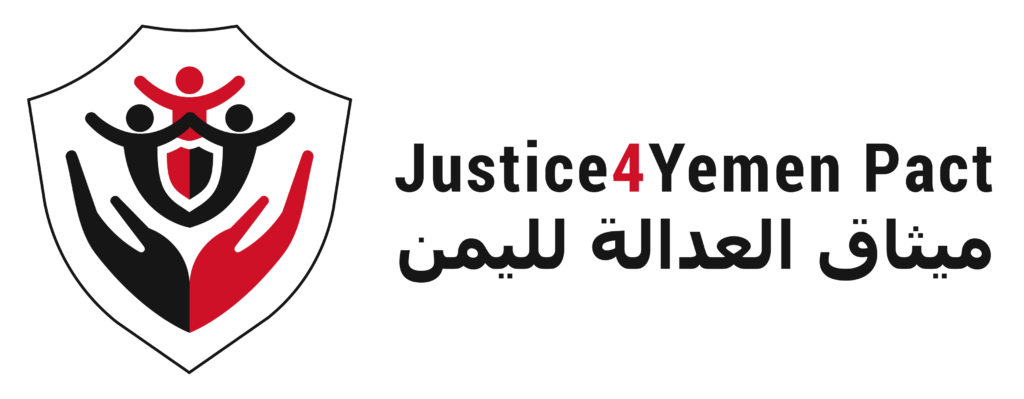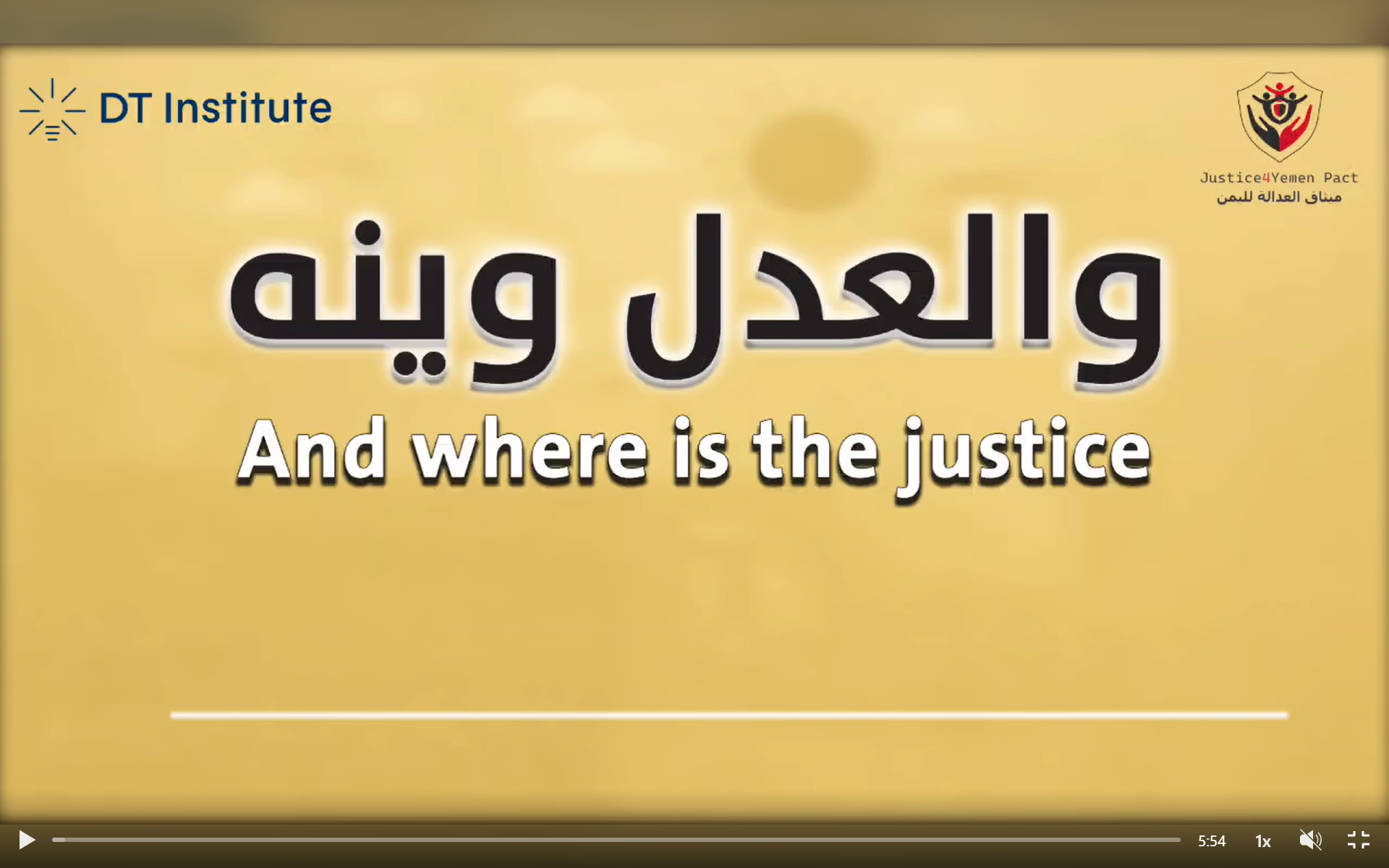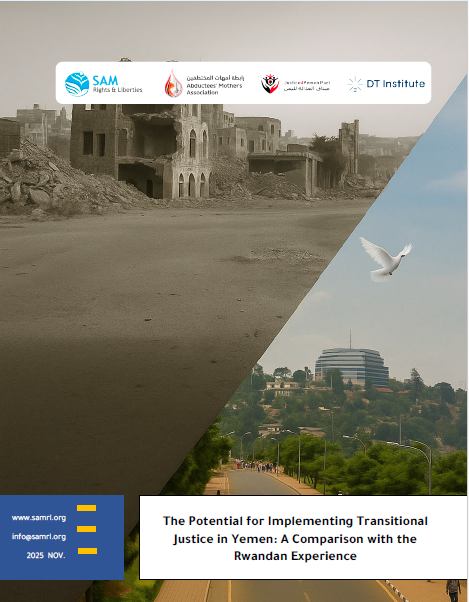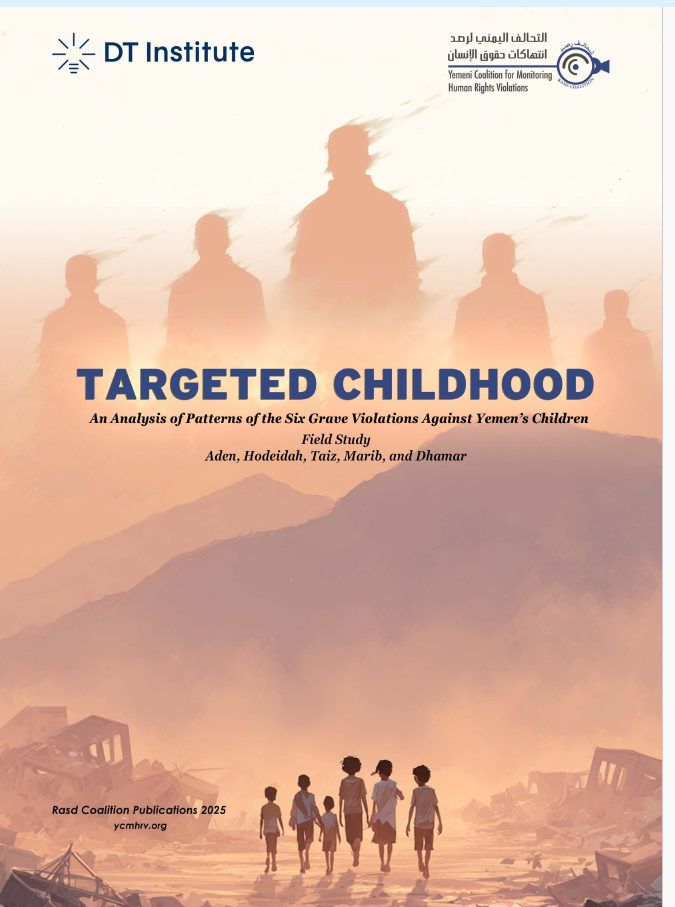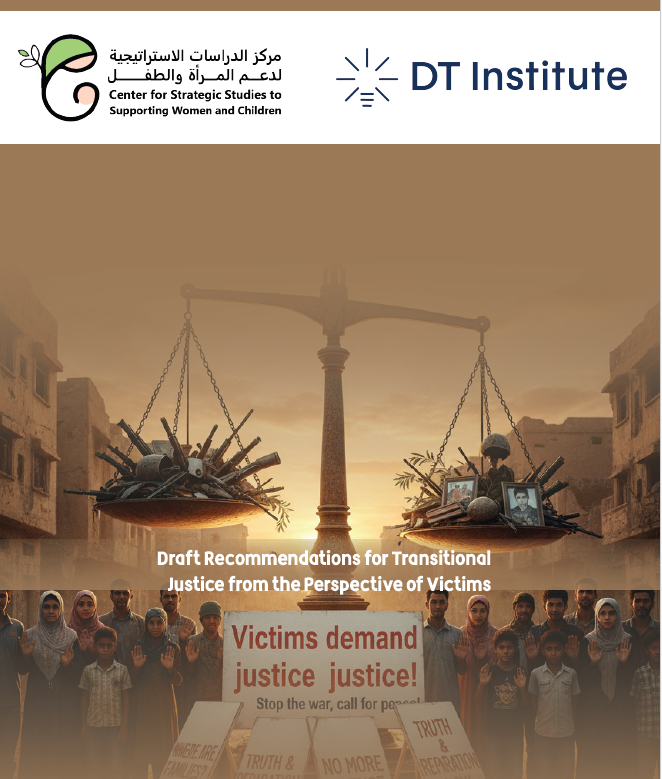| Program Name: | Supporting Peace in Yemen through Accountability, Reconciliation, and Knowledge-Sharing (SPARK) |
| Initiative Name: | Music as a Path to Transitional Justice |
1. Overview of the SPARK Program
In June 2025, five members of the Justice4Yemen Pact (J4YP), a coalition of 10 Yemeni civil society organizations, joined the SPARK team, composed of DT Institute and its local partners, the Abductees’ Mothers Association (AMA) and SAM for Rights and Liberties (“SAM”), to launch advocacy campaigns to complement and expand the geographic scope of restorative justice pilots and raising awareness initiatives in Taiz and Marib.
The pilots aim to foster reconciliation and resolve community-level public disputes that have caused human rights violations. While the advocacy campaigns focus on raising community awareness of transitional justice – its mechanisms, opportunities for engagement, and importance for sustainable peace in Yemen – enabling replication of reconciliation mechanisms and community involvement in national transitional justice processes.
This model was designed in response to the findings of The Path Towards Peace, a research study published by SPARK in April 2025. This study captured local understandings of transitional justice (TJ) across Yemen, revealing that 64.3 percent of community members prioritize reconciliation and war-ending efforts over retributive accountability. Moreover, it further revealed that 51 percent of the research sample had no knowledge of transitional justice at all – identifying a crucial need for education. Participants identified clear roles for civil society: initiating dialogue and reconciliation, offering legal and financial aid to victims, raising TJ awareness, and documenting violations.
To address these gaps, SPARK works to strengthen locally owned mechanisms of reconciliation that respond to community demands for peace over retribution. At the same time, the program builds resilience within divided communities, creating sustainable pathways for dialogue and conflict resolution. Through inclusive approaches, such as victim-centered advocacy campaigns and innovative cultural initiatives, like music for reconciliation, SPARK ensures that women, youth, and marginalized groups are not only participants, but central drivers of Yemen’s transitional justice journey. With donor support, these efforts can be scaled to reach more communities, ensuring that reconciliation and peace take root from the group up.
2. Initiative Spotlight: Music as a Path to Transitional Justice
The cultural and communal significance of music cannot be understated, particularly in Yemen where various communities maintain their own traditional and cultural styles of music. Throughout the ongoing war, music has been used as a tool of resistance, comfort, propaganda, and, of course, as an ongoing expression of cultural identity.
The Houthi (Ansar Allah) forces, in particular, have weaponized the tribal and traditional practice of zawamil throughout the conflict. Zawamil is a traditional Yemeni poetic and chant-like art evolving from a tribal method of dialogue performed during celebrations and used to inspire fighters before battle. The Houthis co-opted the artform, utilizing modern production to publish high-quality music videos to zawamil with lyrics directly responding to current events, criticizing their enemies, encouraging recruitment and fighting, and promoting their broader war effort and agenda.
However, music is also sacred to Yemen’s heritage as signified by Yemen’s National Song Day, celebrated annually on July 1 – even throughout the war – to commemorate and preserve Yemen’s rich musical heritage. In this sense, music can – and often has been employed throughout Yemen’s history – as a tool bridging between divisions among communities and fractured societies impacted by the conflict.
Under this initiative, J4YP partner, Al-Amal Women’s and Sociocultural Foundation (AWSF) wrote, composed, and produced a song and music video, aiming to do just this.
The song, entitled Where is Justice, promotes reconciliation and transitional justice by envisioning a Yemen without impunity, where sustainable peace prevails, and victims’ atrocities are acknowledged. The SPARK team recruited local Yemenis to assist in composition and production of the song, which was also recorded by a Yemeni local in the local dialect to ensure understanding and familiarity among Yemenis.
The music video featured the song’s moving lyrics, which spoke of truth and justice and their value to victims of atrocities in Yemen. In doing so, the lyrics centered on victims and the injustice of the violations they faced at the beginning of the song. By the end of the song, the lyrics transitioned to envision sustainable peace in Yemen, brought about by transitional justice.
An excerpt from the song is available below (translated into English):
And where is justice?
Justice is lost, and fairness is gone.
How many injustices exist among God’s creations?
How many souls lie in sorrow and oppression?
The kind-hearted have left, and so many remain wronged.
When we speak of justice, they say it is defeated.
I witness truth and justice within the souls of the people.
…
Yemen of goodness,
Of justice, where every law is upheld,
Homeland of noble tribes,
Reaching high above the stars
In the land of peace, every aggressor is defeated,
There, broken souls are gently mended,
We are the people of reconciliation, the best of folks,
And whoever walks the path of reconciliation benefits his people.
The lyrics sought to evoke a sense of passionate and complex familiarity for victims – prompting them to consider the violations they faced and to envision a Yemen in which peace and justice prevail over perpetrators to champion victims and local communities. Moreover, the song sought to create a sense of responsibility among community members – that reconciliation is (in part) their responsibility, encouraging them to mend community and societal divisions and disputes.
💬 “Songs have played a powerful role throughout the Yemeni war – shaping emotions, telling stories, and influencing collective memory. Today, as we work towards transitional justice and reconciliation, we need more songs that call for peace, truth, and healing. Music can reach hearts, where politics cannot. In this stage, it is vital to inspire unity and hope through art.” – Sahar Mohammed, Program Assistant, DT Institute
4. Learning, Documentation, and Replication
In publishing the song, AWSF employed various types of outreach, including social media, radio stations, and community broadcast events. They circulated a multitude of materials, including the song, lyrics video, posters, 1and an additional video, produced by local activists, who utilized the song to document protests in Mukalla.
AWSF blasted the song and music video across their platforms, including their website, 2Facebook,3 Instagram, LinkedIn, 4YouTube, WhatsApp,5 and X. The video was also published on the J4YP website and YouTube channel, which garnered over 651 views and 469 engagements since the video was posted. On Facebook alone, the video music obtained over 35,000 views with users leaving impassioned comments. In total, the song generated over 37,107 views and over 50 interactions from individual online users. AWSF’s following across platforms also increased with over 300 unique followers added since the song was released.
💬 “Very wonderful. We aspire to transitional justice for Yemen. #JusticeforYemen” – local Yemeni Facebook user
Local radio stations, Al-Amal FM Radio and Rabat Radio broadcasted the song to over half a million prospective listeners throughout Al Mukalla and online, as well. The song was also aired in-person at Al Mukalla park, one of the largest parks in Al Mukalla city, the capital of Hadhramaut. Its broadcast coincided with strong community tensions, throughout both the city and the broader region, as mass protests and demonstrations denouncing the deterioration in public services and economic and living conditions.
Protesters felt solidarity with the song, which illustrated their most prominent demands going straight to the heart of their discontent. They took the song, specifically selecting the portion calling for justice, and overlayed scenes of the protest. The video was re-shared and discussed over WhatsApp groups, including established chats belonging to youth groups in Hadhramaut as well. The songs spurred innovative and productive conversations, wherein one participant noted that he has documents on corruption.
The most prominent demands of the protest – holding corrupt individuals accountable, which ignited due to the killing of a young man by security forces – are shared by transitional justice and promoted by the work of SPARK partners through restorative justice pilots, raising awareness initiatives, and advocacy campaigns like Where is Justice. These initiatives foster encouragement and understanding among community members, enabling them to take dispute resolution and reconciliation into their own hands, calling for justice as they see fit.
The music initiative was not simply an artistic production. It quickly became a powerful tool for community mobilization and awareness-raising around transitional justice. By using music, a universal language that transcends political divides, social barriers, and even literacy gaps, the campaign reached diverse audiences across Yemen in ways traditional advocacy often cannot. The victim-centered lyrics reflected the pain of violations while envisioning a just and peaceful future, directly aligning with international best practices in transitional justice that prioritize victims’ voices and lived experiences. In doing so, the initiative created both an emotional connection and a sense of responsibility among community members, inspiring dialogue, reflection, and participation in reconciliation efforts.
5. Scaling the Impact
The urgent need for transitional justice in Yemen is clear. Moreover, after over a decade of failed national peace talks in which victim and community needs were disregarded, the urgent need for victim- and community-led transitional justice is even more clear. The role of civil society and the goal of the SPARK program is to foster and provide the necessary skills, tools, and knowledge required by local communities to lead such transitional justice processes as part of Yemen’s national peacebuilding.
“Music can be a great source of inspiration – this is the first step in awakening and activating community awareness and involvement in transitional justice. In many areas – just as with the protests in Al Mukalla – local community members are already calling for transitional justice. They just don’t know it,” explained Lynn Arbid, Program Officer at DT Institute. “The passion and need are there. When locals are able to combine these with the necessary knowledge, the sky becomes the limit, and transitional justice processes are able to be put into action.”
By raising awareness of transitional justice and promoting reconciliation, justice, and victim-led healing,
advocacy campaigns foster a sense of community responsibility to operationalize transitional justice principles. They envision transitional justice efforts, rooted in local ownership, dignity, and dialogue, serving as foundations for broader restorative justice pilots and raising awareness initiatives.
“Arts and culture have the unique ability to transcend political divides and reach people in ways traditional advocacy cannot, helping communities confront past violations and imagine a future built on reconciliation,” states Feras Hamdouni, Senior Program Manager at DT Institute. “These local successes not only repair trust and center victims’ voices but also offer national actors concrete models for building an inclusive and sustainable peace process rooted in local ownership and legitimacy.”
Yet the scale of the challenge far exceeds current resources. With greater donor investment, SPARK could expand restorative justice pilots to additional governorates, reaching thousands more Yemenis with awareness campaigns and victim-centered initiatives and strengthening the capacity of civil society to engage directly in national dialogues on reconciliation. It would also allow the SPARK team to replicate innovative approaches, such as the use of music and cultural expression for advocacy, on a wider scale, while also ensuring systematic documentation and lessons-learned are fed into national transitional justice mechanisms. This is a unique opportunity for donors to invest in scalable, locally led solutions that bridge the gap between grassroots reconciliation and national peacebuilding.

